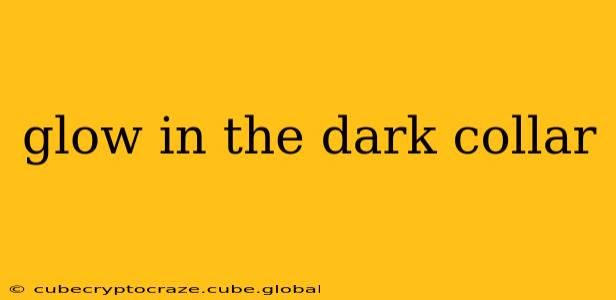Glow-in-the-dark collars have become increasingly popular for both pets and people, offering a unique blend of safety and style. Whether you're looking to enhance your pet's visibility on nighttime walks or add a fun, futuristic touch to your own outfit, understanding the different types, safety considerations, and applications is crucial. This comprehensive guide explores everything you need to know about glow-in-the-dark collars.
How Do Glow-in-the-Dark Collars Work?
Glow-in-the-dark collars utilize either phosphorescent or fluorescent materials. Phosphorescent materials absorb light and then slowly release it over time, creating a gradual glow that can last for several hours after exposure to a light source. Fluorescent materials, on the other hand, require a continuous light source (like a blacklight) to glow. Most glow-in-the-dark collars for pets and people utilize phosphorescent materials for their practical, long-lasting glow.
What are the Benefits of Using a Glow-in-the-Dark Collar?
The primary benefit is enhanced visibility, especially crucial for nighttime walks with pets. A brightly glowing collar significantly reduces the risk of accidents by making your pet easily visible to drivers. For people, glow-in-the-dark collars can improve safety during evening activities like running, cycling, or walking in low-light conditions. Beyond safety, they add a unique, fun element to your style.
Are Glow-in-the-Dark Collars Safe for Pets?
Generally, glow-in-the-dark collars are safe for pets, provided they are made from non-toxic materials and are properly fitted. Always check the collar for any potential choking hazards, loose threads, or small parts that your pet could ingest. Choose collars made from durable, high-quality materials that can withstand chewing and tugging. Opt for adjustable collars to ensure a comfortable and secure fit. If your pet shows any signs of irritation or discomfort, remove the collar immediately.
What are the Different Types of Glow-in-the-Dark Collars Available?
The market offers a variety of glow-in-the-dark collars for different needs and preferences. These include:
- Standard Glow Collars: These are the most common type, offering a basic glow-in-the-dark function.
- Reflective Glow Collars: Some collars combine glow-in-the-dark material with reflective elements for maximum visibility. The reflective material bounces back light from headlights or other light sources.
- LED Glow Collars: These collars contain integrated LED lights that provide a brighter, more intense glow. However, these usually require batteries.
How Long Does a Glow-in-the-Dark Collar Glow?
The duration of the glow depends on the material used and the intensity of the light source it was charged with. A high-quality phosphorescent collar can glow for several hours after a sufficient charge, while cheaper options may fade more quickly. The initial glow is typically the brightest, gradually diminishing over time.
Where Can I Buy a Glow-in-the-Dark Collar?
Glow-in-the-dark collars are widely available online and in pet stores, sporting goods stores, and even some general retailers. When choosing a collar, prioritize quality, safety, and durability. Read reviews and compare prices before making a purchase.
How to Make a Glow-in-the-Dark Collar at Home?
While purchasing a pre-made collar is usually the easiest option, there are ways to add glow-in-the-dark features to existing collars. You can find glow-in-the-dark paint or fabric markers specifically designed for this purpose. Remember to always follow the manufacturer’s instructions and ensure the materials are safe for your pet or for your own use.
By understanding the different types, safety precautions, and functionalities of glow-in-the-dark collars, you can make an informed decision that prioritizes safety and style. Whether for your furry friend or for yourself, these collars offer a practical and fun way to enhance visibility and safety, especially during low-light conditions.
